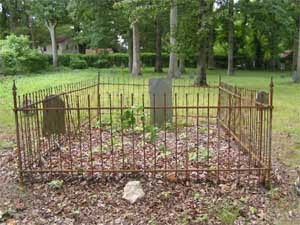Covenanters Begin with Colorful Ceremony
 Following the first schism of the Presbyterian Church in 1741, Rev. Alexander Craighead in 1742 argued that the New Side Presbyterian branch should renew the historic Scottish National Covenant of 1581 and also the Solemn League and Covenant of 1643, thus committing themselves to be in opposition to the British government. When the New Side Presbytery responded with opposition to the proposed covenant, and stated that Craighead’s views were full “of treason, sedition, and distraction,” Craighead and his congregation, the Middle Octorara Presbyterian Church in Eastern Pennsylvania, withdrew from the New Side Presbyterians on November 11, 1743. They then renewed these covenants themselves with four swords pointing to the four winds.
Following the first schism of the Presbyterian Church in 1741, Rev. Alexander Craighead in 1742 argued that the New Side Presbyterian branch should renew the historic Scottish National Covenant of 1581 and also the Solemn League and Covenant of 1643, thus committing themselves to be in opposition to the British government. When the New Side Presbytery responded with opposition to the proposed covenant, and stated that Craighead’s views were full “of treason, sedition, and distraction,” Craighead and his congregation, the Middle Octorara Presbyterian Church in Eastern Pennsylvania, withdrew from the New Side Presbyterians on November 11, 1743. They then renewed these covenants themselves with four swords pointing to the four winds.
In their declaration, they professed their adherence to the true Reformed Presbyterian religion, in doctrine, worship, discipline, and government, as it is contained in the Word of God and summed up in the Westminster Standards, along with the book of church order, which included the directory of worship and the covenants of the mother church.
Further protestations were made against the Adopting Act of 1729, which gave allowance to the ministers and elders of the Presbyterian Church in America to declare exceptions to the subordinate standards of the church. They charged that the present adoption act was “contrary to the true Constitution of the Presbyterian Reformed Church of Christ.:
Last, they protested against the rulers of England as having any legal right to rule over the colonies. The leaders of the New Side Presbyterians were not ready to do that in 1743, but a bare three decades later, that is exactly what American Presbyterians did, when they supported the Revolution.
The significance of the drawn swords was to remember the heritage of their Covenanter forefathers, who adhered to a true Reformation. The swords were a pledge to defend their lives and their religion rather than relinquish it. They wanted to stand body and soul with their spiritual forefathers in this matter.
 > Gravesite of the Rev. Alexander Craighead, at the Sugaw Creek Presbyterian Church in Mecklenburg County, NC.
> Gravesite of the Rev. Alexander Craighead, at the Sugaw Creek Presbyterian Church in Mecklenburg County, NC.
Words to live by: One of the reasons why this historical devotional is being published by the PCA Historical Center is that Presbyterians in our pews, and even some behind our pulpits, often do not know the history of our Church. And in not knowing it, they can fail to appreciate the valiant stands for righteousness and against wickedness which our forefathers took at great sacrifice to themselves and their families.
Reader, you need to make the PCA Historical Center’s pages a “favorite” on your computer, and check with it frequently to read the resources and frequent new additions there. You might also send some financial help to the Historical Center regularly, and have your church put the Center in their annual benevolences. If we forget the past, we will continue to make mistakes in our church faith and life in the present and future.
27 Only conduct yourselves in a manner worthy of the gospel of Christ, so that whether I come and see you or remain absent, I will hear of you that you are standing firm in one spirit, with one mind striving together for the faith of the gospel;
28 in no way alarmed by your opponents—which is a sign of destruction for them, but of salvation for you, and that too, from God.
29 For to you it has been granted for Christ’s sake, not only to believe in Him, but also to suffer for His sake,
30 experiencing the sameconflict which you saw in me, and now hear to be in me.
—(Philippians 1:27-30, NASB)
